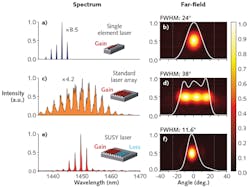Laser Arrays: Supersymmetry scales up radiance of coupled laser arrays
In particle physics, the concept of supersymmetry (SUSY) implies that each type of boson has a supersymmetric counterpart or superpartner fermion, and vice versa. The SUSY theory offers a unified description of the fundamental interactions, and sheds light on whether or not dark matter exists. Although the existence of superpartner particles in high-energy physics has yet to be detected, the concept of SUSY has successfully found its way into other physical disciplines such as lasers and optics.
One such application of supersymmetry has been implemented in laser physics, wherein researchers at the College of Optics and Photonics at the University of Central Florida (CREOL; Orlando, FL) and Michigan Technological University (Houghton, MI) have developed a supersymmetric laser array that couples high-energy modes from a coupled semiconductor laser cavity to the lossy modes of an adjacent superpartner cavity, effectively suppressing the low-quality (low-Q) undesirable modes and amplifying the high-Q fundamental mode to increase the output radiance of the overall array.1
Coupled cavities
To fabricate the supersymmetric laser array, a high-gain semiconductor laser array (or “standard” array) is first created lithographically through the evanescent coupling of five adjacent laser cavities. The five cavities are indium gallium arsenide (InGaAs) ridge waveguides that support only the lowest-order TE0 mode when pumped by a 1064 nm fiber laser.
Using SUSY formalism and finite-element modeling, an array of four laser cavities with eigenmodes matched to the high-energy array were created as the “lossy” (unpumped) superpartner and lithographically etched next to the five-cavity main array. This SUSY cavity represents the supersymmetric array that eliminates unwanted modes.
The near- and far-field emission patterns can be compared from a single-laser cavity, a five-cavity standard array, and the nine-cavity supersymmetric laser array (see figure). Although the five-cavity array produces a radiant output, it is “multimoded” in nature with higher-order components that unfortunately represent a noise signature. But the SUSY array produces a single-mode output with only fundamental-mode lasing with higher purity and a higher Q factor.
SUSY lasing occurs because the superpartner array is designed to support modes whose propagation constants are equal to the higher-order modes of the main array. Here, the main supermodes of the five-cavity array are experiencing gain while the four-cavity superpartner experiences loss (it is left unpumped). All higher-order modes of the main array couple to the modes of the lossy superpartner except the main mode of the primary array. As a result, the superpartner lowers the Q factor of undesired modes and suppresses them in favor of the fundamental mode of the main array.
The need for high-quality laser cavities is exemplified in this architecture, which can be scaled in radiance as the number of gain cavities is increased. Furthermore, the design is forgiving in terms of fabrication errors and imperfections, resisting first-order perturbations and relaxing phase-locking requirements. One representative array lased at a wavelength of 1450 nm, and the beam divergence shrank by a factor of 3.3 compared to the standard array.
“We foresee many applications of supersymmetry wherever there is a need for high-power integrated laser arrays with high beam quality,” says Mercedeh Khajavikhan, associate professor of optics & photonics at CREOL. “For example, such SUSY laser systems may find applications in surgery, lidar, drilling, and welding, to mention a few.”
REFERENCE
1. M. P. Hokmabadi et al., Science, 363, 6427, 623–626 (Feb. 8, 2019).

Gail Overton | Senior Editor (2004-2020)
Gail has more than 30 years of engineering, marketing, product management, and editorial experience in the photonics and optical communications industry. Before joining the staff at Laser Focus World in 2004, she held many product management and product marketing roles in the fiber-optics industry, most notably at Hughes (El Segundo, CA), GTE Labs (Waltham, MA), Corning (Corning, NY), Photon Kinetics (Beaverton, OR), and Newport Corporation (Irvine, CA). During her marketing career, Gail published articles in WDM Solutions and Sensors magazine and traveled internationally to conduct product and sales training. Gail received her BS degree in physics, with an emphasis in optics, from San Diego State University in San Diego, CA in May 1986.
